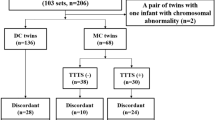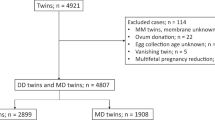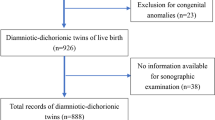Abstract
BACKGROUND:
Monochorionic-diamniotic twins (MoDi) occur in 0.3% of all pregnancies. Twin-to-twin transfusion syndrome (TTS) that occurs in 20% of MoDi pregnancies is associated with high perinatal morbidity and mortality. MoDi twins without TTS are more frequent (80%) but have been scarcely reported.
OBJECTIVE:
To study perinatal morbidity and mortality of 74 MoDi twin sets without TTS and to compare it to that of 38 sets of MoDi twins with TTS.
METHODS:
Chorionicity was determined by gender and placental examination. Gestational age (GA) was set by sonography and pediatric examination. TTS was diagnosed clinically and by sonography, discordance was defined by twins birth weight difference ≥20%, and fetal growth restriction was determined by using a twin-specific nomogram.
RESULTS:
MoDi twin pregnancies without and with TTS were similar in demographics, live births, history of preeclampsia, fetal distress and cesarean delivery. They were different (p<0.01) in discordant pregnancies (36 and 79%), GA at delivery (32 and 29 weeks) intrauterine growth restriction (39 and 89%) and neonatal mortality (12 and 36%). Concordant (47 sets) and discordant (27 sets) MoDi twins without TTS were clinically similar.
CONCLUSIONS:
MoDi twins without TTS have high rates of birth weight discordance, fetal growth restriction, fetal distress, prematurity and cesarean delivery. Although their perinatal mortality is low, the reported occurrence and the short- and long-term impacts of fetal and neonatal morbidities warrants attention.
This is a preview of subscription content, access via your institution
Access options
Subscribe to this journal
Receive 12 print issues and online access
$259.00 per year
only $21.58 per issue
Buy this article
- Purchase on Springer Link
- Instant access to full article PDF
Prices may be subject to local taxes which are calculated during checkout
Similar content being viewed by others
References
Martin JA, Hamilton BE, Sutton PD, et al. Birth: final data for 2002. Natl Vital Stat Rep 2003;52:1–27.
Powers WF, Kiely JL . The risks confronting twins: a national prespective. Am J Obstet Gynecol 1994;170:456–461.
Bajoria R, Kingdom J . The case for routine determination of chorionicity and zygosity in multiple pregnancies. Prenat Diagn 1997;17:1207–1225.
Sebire NJ, Snijders RJ, Hughes K, Sepulveda W, Nicolaides KH . The hidden mortality of monochorionic twin pregnancies. Br J Obstet Gynecol 1997;104:1203–1207.
Victoria A, Mora G, Arias F . Perinatal outcome, placental pathology, and severity of discordance in monochorionic and dichorionic twins. Obstet Gynecol 2001;97:310–315.
Dube J, Dodds L, Armson BA . Does chorionicity or zygosity predict adverse perinatal outcomes in twins? Am J Obstet Gynecol 2002;186:579–583.
Lewi L, Van Schoubroeck D, Gratacos E, et al. Monochorionic diamniotic twins: complications and management options. Curr Opin Obstet Gynecol 2003;15:177–194.
Machin GA, Bamforth F, Innes M, McNichol K . Some perinatal characteristics of monozygotic twins who are dichorionic. Am J Med Gen 1995;55:71–76.
Gaziano EP, De Lia JE, Kuhlmann RS . Diamniotic monochorionic twin gestations: an overview. J Matern Fetal Med 2000;9:89–96.
Sherer DM . Adverse perinatal outcome of twin pregnancies according to chorionicity: review of the literature. Am J Perinatol 2001;181:23–37.
Tessen JA, Zlatnik FJ . Monoamniotic twins: a retrospective controlled study. Obstet Gynecol 1991;77:832–834.
Benirschke K . The biology of the twinning process: how placentation influences outcome. Sem Perinatol 1995;19:342–350.
Allen VM, Windrim R, Barrett J, Ohlsson A . Management of monoamniotic twin pregnancies: a case series and systematic review of the literature. Br J Obstet Gynecol 2001;108:931–936.
Van Gemert MJ, Umur A, Tijssen JG, Ross MG . Twin-twin transfusion syndrome: etiology, severity and rational management. Curr Opin Obstet Gynecol 2001;13:193–206.
Bermudez C, Becerra CH, Bornick PW, et al. Placental types and twin-twin transfusion syndrome. Am J Obstet Gynecol 2002;187:489–494.
Bajoria R, Wee L, Anwar S, Ward S . Outcome of twin pregnancies complicated by single intrauterine death in relation to vascular anatomy of the monochorionic placenta. Hum Reprod 1999;14:2124–2130.
Barigye O, Pasquini L, Galea P, Chambers H, Chappell L, Fisk NM . High risk of unexpected late fetal death in monochorionic twins despite intensive ultrasound surveillance: A cohort study. PLoS Med 2005;2:e172.
Hollier LM, McIntire DD, Leveno KJ . Outcome of twin pregnancies according to intrapair birth weight differences. Obstet Gynecol 1999;94:1006–1010.
Sonntag J, Waltz S, Schollmeyer T, Schüppler U, Schröder H, Weisner D . Morbidity and mortality of discordant twins up to 34 weeks of gestational age. Eur J Pediatr 1996;155:224–229.
Malone FD, D'Alton ME . Multiple gestation. In: Creasy RK, Resnik R, Iams JD, editors. Maternal-Fetal Medicine: Principles and Practice. Philadelphia, PA: Saunders; 2004 p. 524–526.
Quintero RA, Morales WJ, Allen MH, Bornick PW, Johnson PK, Kruger M . Staging of twin-twin transfusion syndrome. J Perinatol 1999;19:550–555.
Harman CR . Assessment of fetal health In: Creasy RK, Resnik R, Iams JD, editors. Maternal-Fetal Medicine: Principles and Practice. Philadelphia, PA: Saunders; 2004, p. 357–401.
Gilstrap LC, Leveno KJ, Burris J, Williams ML, Little BB . Diagnosis of birth asphyxia on the basis of fetal pH, Apgar score, and newborn cerebral dysfunction. Am J Obstet Gynecol 1999;161:825–830.
Ananth CV, Vintzileo AM, Shen-Schwarz S, Smulian JC, Lai YL . Standards of birth weight in twin gestations stratified by placental chorionicity. Obstet Gynecol 1998;91:917–924.
Shennan AT, Dunn MS, Ohlsson A, Lennox K, Hoskins EM . Abnormal pulmonary outcomes in premature infants: prediction from oxygen requirement in the neonatal period. Pediatrics 1988;82:527–532.
Papile LA, Burstein J, Burstein R, Koffler H . Incidence and evolution of the subependymal intraventricular hemorrhage: a study of infants with weights less than 1500?g. J Pediatr 1978;92:529–534.
Bajoria R . Vascular anatomy of monochorionic placenta in relation to discordant growth and amniotic fluid volume. Hum Reprod 1998;13:2933–2940.
Denbow ML, Cox P, Taylor M, Hammal DM, Fisk NM . Placental angioarchitecture in monochorionic twin pregnancies: relationship to fetal growth, fetofetal transfusion syndrome. Am J Obstet Gynecol 2000;182:417–426.
Fries MH, Goldstein RB, Kilpatrick SJ, et al. The role of velamentous cord insertion in the etiology of twin-twin transfusion syndrome. Obstet Gynecol 1993;81:569–574.
Machin GA . Velamentous cord insertion in monochorionic twin gestation. J Reprod Med 1997;42:785–789.
Hanley ML, Ananth CV, Shen-Schwarz S, Smulian JC, Lai YL, Vintzileos AM . Placental cord insertion and birth weight discordancy in twin gestations. Obstet Gynecol 2002;99:477–481.
Cheung VYT, Bocking AD, Dasilva OP . Preterm discordant twins: what birth weight difference is significant? Am J Obstet Gynecol 1995;172:955–959.
Chauhan SP, Shields D, Parker D, et al. Detecting fetal growth restriction or discordant growth in twin gestations stratified by placental chorionicity. J Reprod Med 2004;49:279–284.
Bejar R, Vigliocco G, Gramajo H . Antenatal origin of neurologic damage in newborn infants. Am J Obstet Gynecol 1990;162:1230–1236.
Minakami H, Honma Y, Matsubara S, Uchida A, Shiraishi H, Sato I . Effects of placental chorionicity on outcome in twin pregnancies. J Reprod Med 1999;44:595–600.
Burguet A, Monnet E, Pauchard JY, et al. Some risk factors for cerebral palsy in very premature infants: importance of premature rupture of membranes and monochorionic twin placentation. Biol Neonate 1999;75:177–186.
McIntire D, Bloom SL, Casey BM, Leveno KJ . Birth weight in relation to morbidity and mortality among newborn infants. N Engl J Med 1999;340:1234–1238.
Author information
Authors and Affiliations
Rights and permissions
About this article
Cite this article
Cordero, L., Franco, A., Joy, S. et al. Monochorionic Diamniotic Infants Without Twin-to-Twin Transfusion Syndrome. J Perinatol 25, 753–758 (2005). https://doi.org/10.1038/sj.jp.7211405
Published:
Issue Date:
DOI: https://doi.org/10.1038/sj.jp.7211405
This article is cited by
-
Synthesizing Core Outcome Sets for outcomes research in cohort studies: a systematic review
Pediatric Research (2022)
-
Deep-learned placental vessel segmentation for intraoperative video enhancement in fetoscopic surgery
International Journal of Computer Assisted Radiology and Surgery (2019)
-
B-type natriuretic peptide levels are correlated with birth-weight discordance in monochorionic-diamniotic twins without twin–twin transfusion syndrome
Journal of Perinatology (2013)
-
Spezielle Aspekte der Entbindungsplanung bei Zwillingen
Der Gynäkologe (2008)



